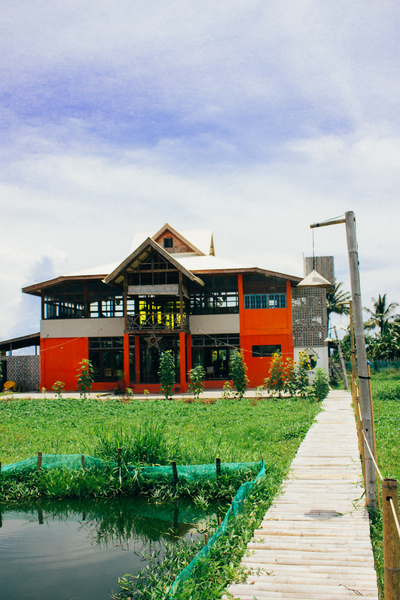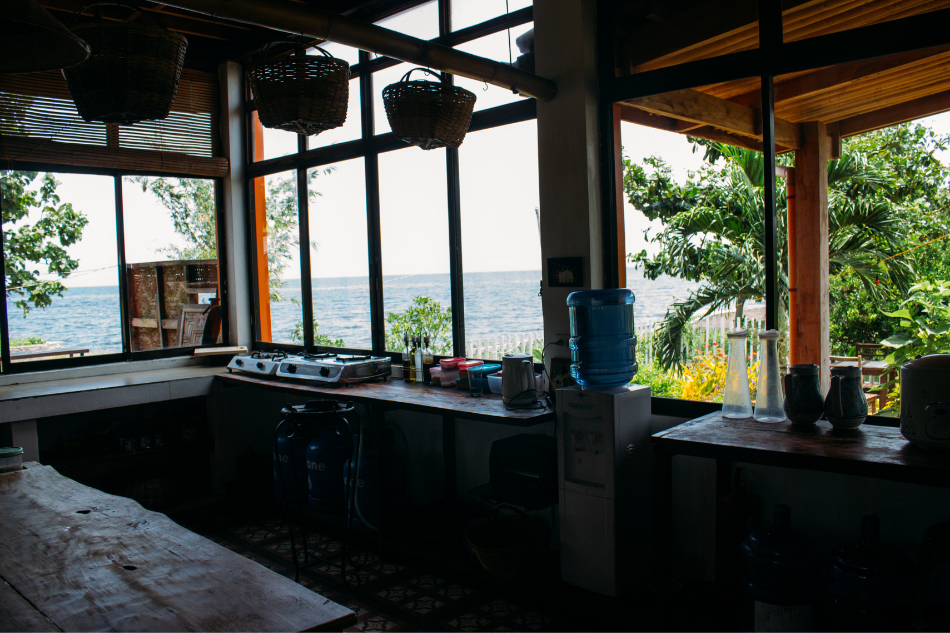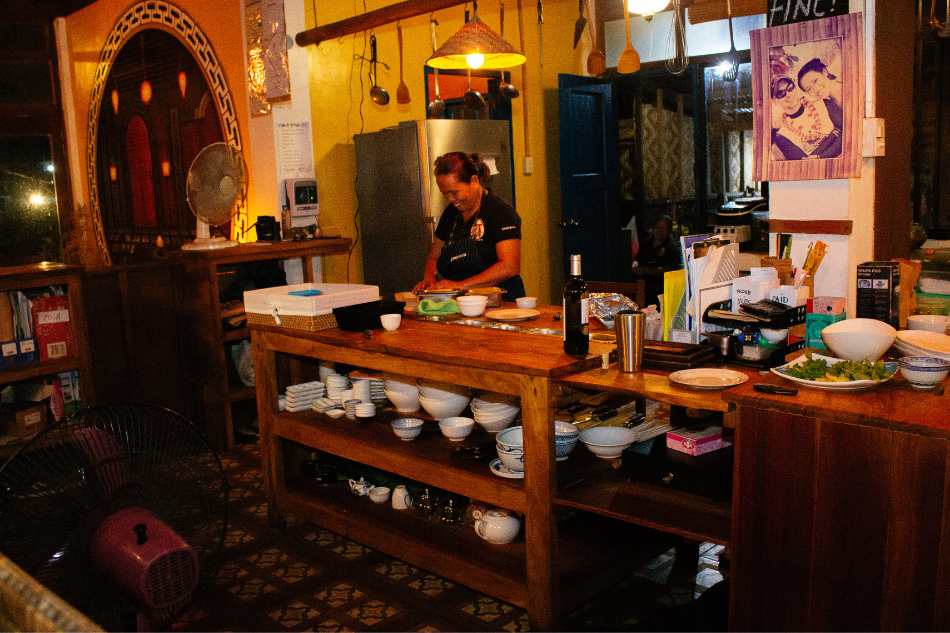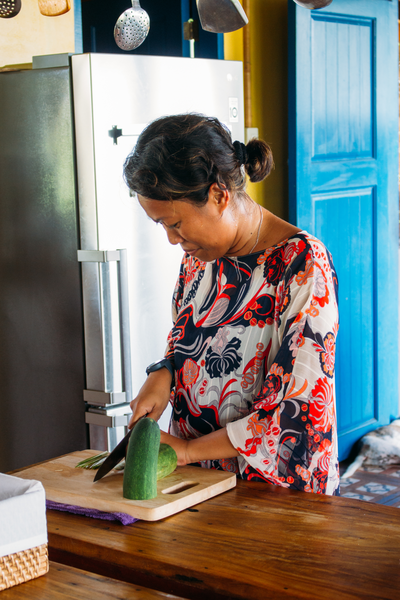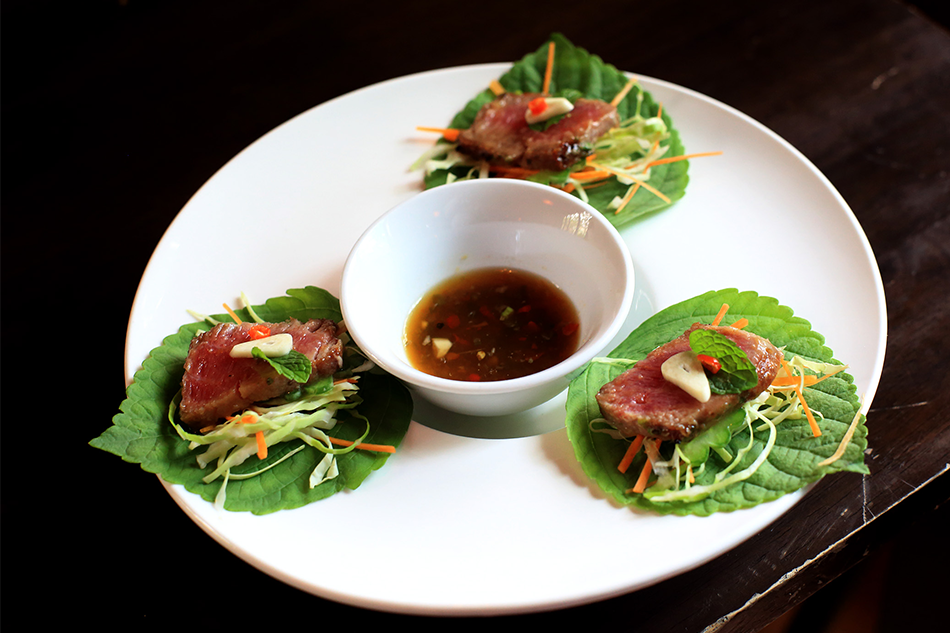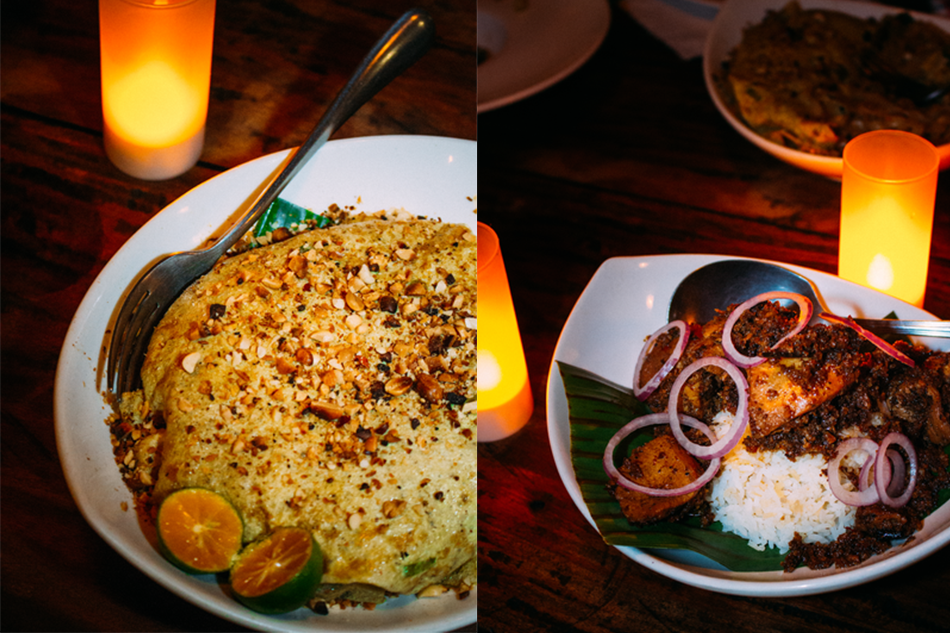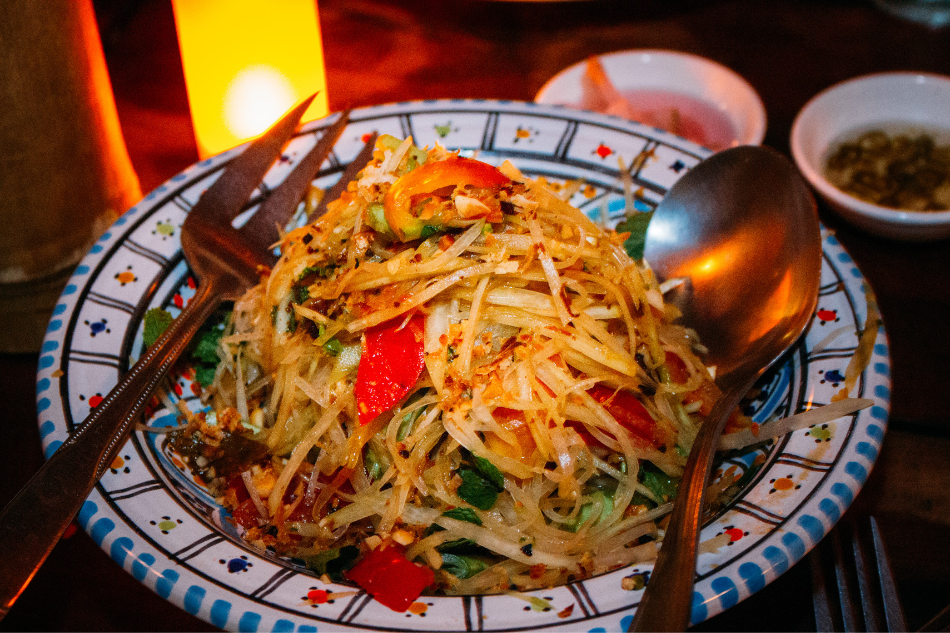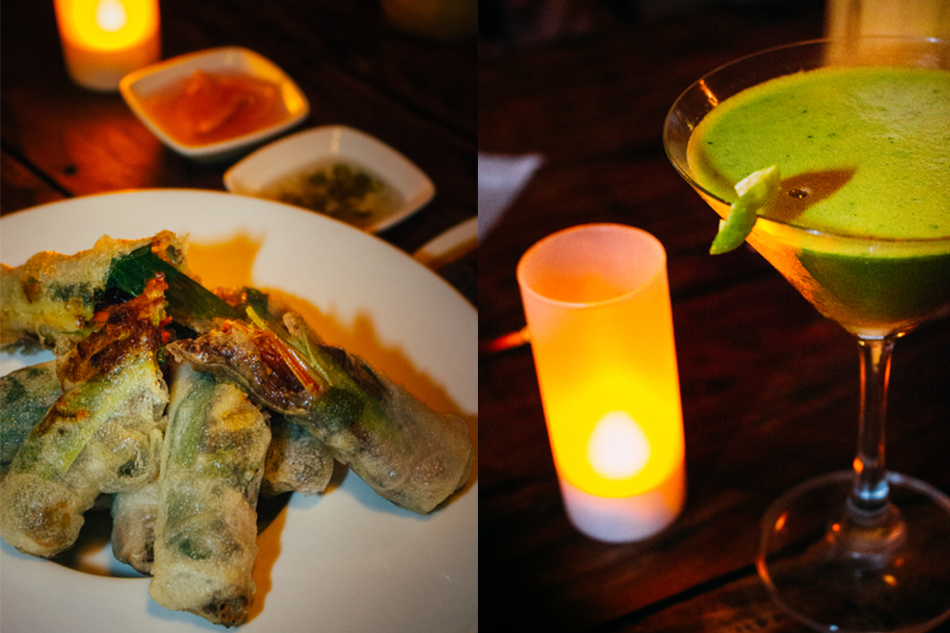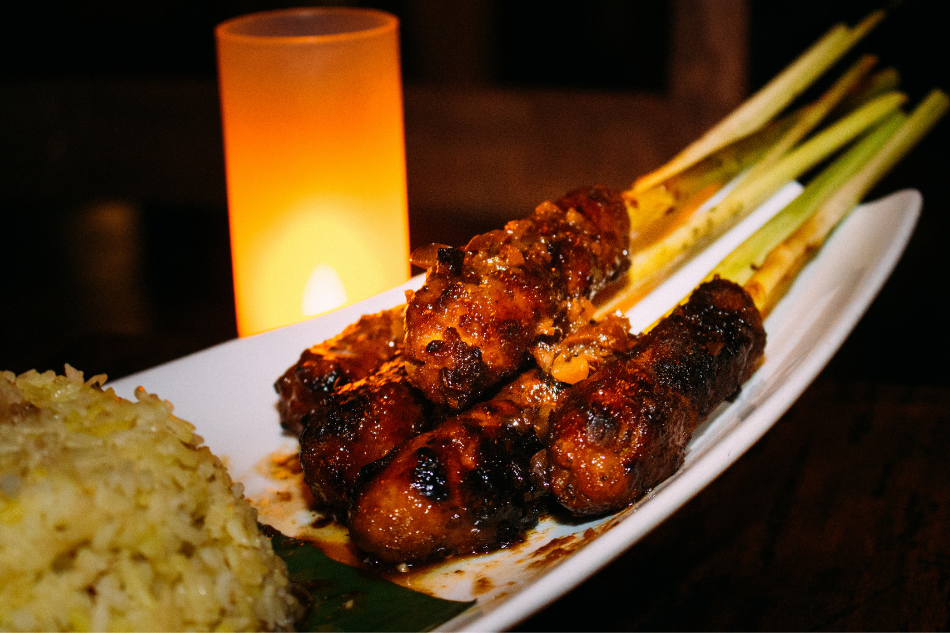This guerrera turned a major heartbreak into an opportunity to find her inner chef
ADVERTISEMENT

Welcome, Kapamilya! We use cookies to improve your browsing experience. Continuing to use this site means you agree to our use of cookies. Tell me more!
This guerrera turned a major heartbreak into an opportunity to find her inner chef
Jerome Gomez
Published Jul 28, 2019 08:59 PM PHT
|
Updated Jul 28, 2019 10:28 PM PHT
If you want to know the motto behind Guerrera, the Camiguin restaurant that sits in the middle of a rice field, you have to find your way to its toilet. Written on a piece of wall between the men’s and ladies’ rooms is an oft ignored truth: “Creativity means not copying.” It’s a quote from the renowned Ferran Adria of the restaurant El Bulli—a very important one it seems as it signaled a turning point in how the Spanish chef approached creation: to move farther and farther away from the influence of what’s already been done.
If you want to know the motto behind Guerrera, the Camiguin restaurant that sits in the middle of a rice field, you have to find your way to its toilet. Written on a piece of wall between the men’s and ladies’ rooms is an oft ignored truth: “Creativity means not copying.” It’s a quote from the renowned Ferran Adria of the restaurant El Bulli—a very important one it seems as it signaled a turning point in how the Spanish chef approached creation: to move farther and farther away from the influence of what’s already been done.
Carmel Therese Almadrones practices what Adria preaches. She is the affable chef of Guerrera which, as per the painting on its facade wall, serves "fine Asian street food." Which means Almadrones takes beloved Asian cuisine staples and gives it a twist inspired by her travels, by techniques, by the produce available to her, or simply by the way she wants it served. In short, they’re not copies.
Carmel Therese Almadrones practices what Adria preaches. She is the affable chef of Guerrera which, as per the painting on its facade wall, serves "fine Asian street food." Which means Almadrones takes beloved Asian cuisine staples and gives it a twist inspired by her travels, by techniques, by the produce available to her, or simply by the way she wants it served. In short, they’re not copies.
You may also like:
You may also like:
Her Chicken Rendang, for example, is one our tastebuds have not encountered before. Most of the ingredients, lemongrass and galangal among them, are sourced from the island, specifically from the periphery of where the restaurant stands in Mambajao. The Indian dried chili is imported from abroad, and the other Indian spices—cinnamon sticks included—are brought in on weekends by her husband Mark who is based in Cebu. The chef likes the Indian dried chili because the color is stronger, the aroma more pungent, compared to the Chinese variety. The elements of Almadrones’s cooking—flavors included—are never tentative about asserting their personality.
Her Chicken Rendang, for example, is one our tastebuds have not encountered before. Most of the ingredients, lemongrass and galangal among them, are sourced from the island, specifically from the periphery of where the restaurant stands in Mambajao. The Indian dried chili is imported from abroad, and the other Indian spices—cinnamon sticks included—are brought in on weekends by her husband Mark who is based in Cebu. The chef likes the Indian dried chili because the color is stronger, the aroma more pungent, compared to the Chinese variety. The elements of Almadrones’s cooking—flavors included—are never tentative about asserting their personality.
“That curry has to be cooked minimum—just the paste—four hours,” Almadrones points out, still talking about her wonderful rendang. “Cook it down, low heat, and then maybe another four hours to cook with the meat.” The real surprise in the dish is in the coconut. It is not squeezed. The coconut meat is grated, and then roasted. “So the taste stays and it’s not dry.”
“That curry has to be cooked minimum—just the paste—four hours,” Almadrones points out, still talking about her wonderful rendang. “Cook it down, low heat, and then maybe another four hours to cook with the meat.” The real surprise in the dish is in the coconut. It is not squeezed. The coconut meat is grated, and then roasted. “So the taste stays and it’s not dry.”
ADVERTISEMENT
If anything, the dishes at Guerrera are not only upgrades from the familiar—it’s like someone took your favorite song, did a cover, kept all the bits and pieces of the lyrics and melody you love intact, and then added some inspired surprises. “I don’t believe in the word original, because I don’t think I can go back to really learning how it’s made,” says the chef while sitting on a bar stool, trying to stay composed for the camera. “But I believe you can use it as an inspiration to create your own. That’s who we are.”
If anything, the dishes at Guerrera are not only upgrades from the familiar—it’s like someone took your favorite song, did a cover, kept all the bits and pieces of the lyrics and melody you love intact, and then added some inspired surprises. “I don’t believe in the word original, because I don’t think I can go back to really learning how it’s made,” says the chef while sitting on a bar stool, trying to stay composed for the camera. “But I believe you can use it as an inspiration to create your own. That’s who we are.”
Who is the guerrera?
Who is the guerrera?
Carmel—let’s just call her that because it’s shorter and also because it sounds, as she herself points out, “Like caramel” which, it just so happens, is the color of her skin.
Carmel—let’s just call her that because it’s shorter and also because it sounds, as she herself points out, “Like caramel” which, it just so happens, is the color of her skin.
Carmel was born and raised in Cebu and for years being a chef was the farthest from her thoughts. She studied computer science and accountancy. But when she met her husband, an adventurous American, food started to take on a different relevance in her life. His love for travel introduced the Cebuana to different flavors and different cuisines. “It made me open about a lot of things,” Carmel says. “When he said let’s explore this cuisine, I said sure. I want to experience traveling because I didn’t have that chance. I had this chance when I met him.”
Carmel was born and raised in Cebu and for years being a chef was the farthest from her thoughts. She studied computer science and accountancy. But when she met her husband, an adventurous American, food started to take on a different relevance in her life. His love for travel introduced the Cebuana to different flavors and different cuisines. “It made me open about a lot of things,” Carmel says. “When he said let’s explore this cuisine, I said sure. I want to experience traveling because I didn’t have that chance. I had this chance when I met him.”
But Carmel didn’t go straight to culinary school even after developing a keener appreciation for exotic flavors. Something else would point her towards that direction. “When we got married we did not talk about having a baby,” the chef begins, telling a story it seems she previously was not comfortable telling. “We just wanted to travel. But it came to a point that [I started thinking] I’m a Filipina, you see people with kids. So I said that I think [kids] are important for me.” She asked her husband if he wanted to explore the possibility of having a kid.
But Carmel didn’t go straight to culinary school even after developing a keener appreciation for exotic flavors. Something else would point her towards that direction. “When we got married we did not talk about having a baby,” the chef begins, telling a story it seems she previously was not comfortable telling. “We just wanted to travel. But it came to a point that [I started thinking] I’m a Filipina, you see people with kids. So I said that I think [kids] are important for me.” She asked her husband if he wanted to explore the possibility of having a kid.
It turns out both of them have limitations. “Both of us have issues,” says Carmel. “He’s a triathlete and I have endometriosis.” Still, the two were not quick to give up. Determined to explore their available options, they tried IVF. It was the best option for Carmel, their doctor said. “I did that for a month. Imagine all those injections. Your tummy turns black with all the injections!” It was not the most pleasant of undertakings, even when her husband was there every step of the way. “We had to do it every morning. [My husband] had to inject me. I had to be in bed for how many months.”
It turns out both of them have limitations. “Both of us have issues,” says Carmel. “He’s a triathlete and I have endometriosis.” Still, the two were not quick to give up. Determined to explore their available options, they tried IVF. It was the best option for Carmel, their doctor said. “I did that for a month. Imagine all those injections. Your tummy turns black with all the injections!” It was not the most pleasant of undertakings, even when her husband was there every step of the way. “We had to do it every morning. [My husband] had to inject me. I had to be in bed for how many months.”
ADVERTISEMENT
After three months of needles, bed confinement and therapy, the IVF didn’t work. And the resulting pain and disappointment proved a lot to contain. “I said to myself I need an outlet, and at the same time I want to be able to grow,” Carmel recalls.
After three months of needles, bed confinement and therapy, the IVF didn’t work. And the resulting pain and disappointment proved a lot to contain. “I said to myself I need an outlet, and at the same time I want to be able to grow,” Carmel recalls.
It was then she thought about going to culinary school. Her husband supported the idea but he wanted her to do it right: “He said you have to be far from me. You have to go to the right school, we’d have to spend money. You can only achieve this if you enjoy what you’re doing—because you might fail. But you can’t be afraid of failure. Are you willing to go abroad for this one?”
It was then she thought about going to culinary school. Her husband supported the idea but he wanted her to do it right: “He said you have to be far from me. You have to go to the right school, we’d have to spend money. You can only achieve this if you enjoy what you’re doing—because you might fail. But you can’t be afraid of failure. Are you willing to go abroad for this one?”
The Guerrera of Cordon Bleu
The Guerrera of Cordon Bleu
During that time it was not the best idea that she travel alone because of the depression—“but I said I will take the risk for my own good. Because I want to be able to say that at least I put up a good fight,” says Carmel. She enrolled in a French school, Le Cordon Bleu, at the suggestion of her husband, and majored in Professional Thai Cuisine, which is a favorite of her husband’s. Personally, she was intrigued by the challenge of taking on a cuisine she had fallen in love with, balancing the four elements of its flavors—sweet, sour, salty and spicy—and coming up with a satisfying result. It was like accounting, she says.
During that time it was not the best idea that she travel alone because of the depression—“but I said I will take the risk for my own good. Because I want to be able to say that at least I put up a good fight,” says Carmel. She enrolled in a French school, Le Cordon Bleu, at the suggestion of her husband, and majored in Professional Thai Cuisine, which is a favorite of her husband’s. Personally, she was intrigued by the challenge of taking on a cuisine she had fallen in love with, balancing the four elements of its flavors—sweet, sour, salty and spicy—and coming up with a satisfying result. It was like accounting, she says.
It wasn’t all smooth sailing, Carmel’s stint at Le Cordon Bleu. “I was hospitalized once while in school because the depression kicked in, but I bounced back. I said I have to fight it. I have to win this battle.”
It wasn’t all smooth sailing, Carmel’s stint at Le Cordon Bleu. “I was hospitalized once while in school because the depression kicked in, but I bounced back. I said I have to fight it. I have to win this battle.”
The school didn’t only teach the determined Cebuana the ways of the French kitchen but it deepened her appreciation for the vocation. “People say I want to be a chef—that’s good but I hope they have the right reason for it,” says Carmel. “Because it’s supposed to have passion and love. This is the career that is not just copy and paste. You have to put in time."
The school didn’t only teach the determined Cebuana the ways of the French kitchen but it deepened her appreciation for the vocation. “People say I want to be a chef—that’s good but I hope they have the right reason for it,” says Carmel. “Because it’s supposed to have passion and love. This is the career that is not just copy and paste. You have to put in time."
ADVERTISEMENT
A Camiguin Dream
A Camiguin Dream
Guerrera is their dream business, hers and her husband’s. But they had opened and closed restaurants before. They started in Cebu with a Vietnamese and Thai joint called Little Saigon, Big Bangkok. “It’s funny because we started in the garage. We rented this place after I graduated from cooking school. Mark said, I don’t want you to forget what you’ve learned,” Carmel relates.
Guerrera is their dream business, hers and her husband’s. But they had opened and closed restaurants before. They started in Cebu with a Vietnamese and Thai joint called Little Saigon, Big Bangkok. “It’s funny because we started in the garage. We rented this place after I graduated from cooking school. Mark said, I don’t want you to forget what you’ve learned,” Carmel relates.
Little Saigon, Big Bangkok became sort of a laboratory, composed of a kitchen, a table, and four chairs. Assisted by her cousin, Carmel would cook dishes every night as if she were serving real customers — when really it was just Mark acting as constant patron. “So he will come and say, 'What’s for dinner tonight?' 'What is this? Explain this to me.' This happened for a month.”
Little Saigon, Big Bangkok became sort of a laboratory, composed of a kitchen, a table, and four chairs. Assisted by her cousin, Carmel would cook dishes every night as if she were serving real customers — when really it was just Mark acting as constant patron. “So he will come and say, 'What’s for dinner tonight?' 'What is this? Explain this to me.' This happened for a month.”
Until one real customer walked in, and then another, and word about their little garage operation spread. “Then one night we came home, and people were lining up. And from one table it became a hundred-seater.” Little Saigon, Big Bangkok got so much good feedback they even had copycats — “which is normal, in my opinion, it helps to make you better. And to also make you realize who you really are.” Since then, the couple have opened a kiosk and a food truck inside a supermarket, among others.
Until one real customer walked in, and then another, and word about their little garage operation spread. “Then one night we came home, and people were lining up. And from one table it became a hundred-seater.” Little Saigon, Big Bangkok got so much good feedback they even had copycats — “which is normal, in my opinion, it helps to make you better. And to also make you realize who you really are.” Since then, the couple have opened a kiosk and a food truck inside a supermarket, among others.
Unfortunately for their Cebuano following, the couple had to close all of these food ventures when they committed to opening their eighth, Guerrera. “Everything closed because we realized that it’s hard to have both worlds, Cebu and Camiguin. I cannot be in many places at once. This cuisine in my opinion, in our opinion—it needs our personal touch. It’s hard to just copy and paste it because it needs love and it needs caring, it needs nurturing.”
Unfortunately for their Cebuano following, the couple had to close all of these food ventures when they committed to opening their eighth, Guerrera. “Everything closed because we realized that it’s hard to have both worlds, Cebu and Camiguin. I cannot be in many places at once. This cuisine in my opinion, in our opinion—it needs our personal touch. It’s hard to just copy and paste it because it needs love and it needs caring, it needs nurturing.”
Why Camiguin? It’s just one of the couple’s favorite places. For their honeymoon, they decided to let the tossing of a coin choose the destination. He loved Camiguin while Carmel, who has never traveled, wanted to see Boracay of which she’s heard many good things. The coin chose Boracay. “It was raining the entire honeymoon,” recalls Carmel. Their gloomy stay in Boracay gave them a more positive appreciation for Camiguin which, on their visit, gave them a lovely welcome in the form of a perfect weather. “We loved that it was peaceful, quiet," recalls Carmel. "He can do a lot of things especially for his triathlon. He can run, he can bike, he can swim. So everything is here."
Why Camiguin? It’s just one of the couple’s favorite places. For their honeymoon, they decided to let the tossing of a coin choose the destination. He loved Camiguin while Carmel, who has never traveled, wanted to see Boracay of which she’s heard many good things. The coin chose Boracay. “It was raining the entire honeymoon,” recalls Carmel. Their gloomy stay in Boracay gave them a more positive appreciation for Camiguin which, on their visit, gave them a lovely welcome in the form of a perfect weather. “We loved that it was peaceful, quiet," recalls Carmel. "He can do a lot of things especially for his triathlon. He can run, he can bike, he can swim. So everything is here."
ADVERTISEMENT
Still it took years before they could find their place in Camiguin, and it’s not surprising the search was difficult. Their travels to Bali sparked an idea of putting up a restaurant in the middle of a rice paddy, so they wanted a rice paddy but also they wanted to be near the beach. Eventually, the island gods blessed the couple with a location even more wonderful. Yes, Guerrera, a simple, spacious two-story brick red structure, is located in the middle of a small rice field in Camiguin but also, at the immediate back of the restaurant is the ocean, and across its entrance is a view of a gorgeous mountain. What else can they ask for?
Magical place
Magical place
A restaurant in the middle of a rice field may have been done before, but the universe has conspired to make Guerrera its own unique attraction. The enviable location, combined with Carmel’s nurturing presence, and her inventive take on Asian cuisine, makes dining in Guerrera quite the magical experience hard to come by anywhere else. Walking on wooden planks to reach the restaurant from the paved street, the sound of crickets at dusk, the dark blue sky all add to the charm.
A restaurant in the middle of a rice field may have been done before, but the universe has conspired to make Guerrera its own unique attraction. The enviable location, combined with Carmel’s nurturing presence, and her inventive take on Asian cuisine, makes dining in Guerrera quite the magical experience hard to come by anywhere else. Walking on wooden planks to reach the restaurant from the paved street, the sound of crickets at dusk, the dark blue sky all add to the charm.
Every dish Carmel lets outs of her open kitchen is a product of much thought and experimentation. Her version of the Thai leaf snack, Miang Kham, for example, with its Korean sesame leaf, its bouquet of spices, and its tamarind sauce, is a fireworks spectacle in one bite. Her satay, whose thin slices of meat are pounded and made into sausages—and then skewered not by bamboo sticks but lemongrass leaves which abound in the restaurant’s peripheries—is inspired and a delight to devour. Everything is bursting with personality. Just like the place. Just like Carmel herself who, we discovered, also stays true to this other mantra: “The person eating should be able to taste the love from the person who cooked the meal."
Every dish Carmel lets outs of her open kitchen is a product of much thought and experimentation. Her version of the Thai leaf snack, Miang Kham, for example, with its Korean sesame leaf, its bouquet of spices, and its tamarind sauce, is a fireworks spectacle in one bite. Her satay, whose thin slices of meat are pounded and made into sausages—and then skewered not by bamboo sticks but lemongrass leaves which abound in the restaurant’s peripheries—is inspired and a delight to devour. Everything is bursting with personality. Just like the place. Just like Carmel herself who, we discovered, also stays true to this other mantra: “The person eating should be able to taste the love from the person who cooked the meal."
That’s not Ferran Adria talking; that’s the chef of Guerrera.
That’s not Ferran Adria talking; that’s the chef of Guerrera.
Photographs by Andre Drilon
ADVERTISEMENT
ADVERTISEMENT



